A common way to refer to an intersection is to use the phrase “it’s at [street A] and [street B].” When I recently heard such a phrase in a podcast, I tried to find that location by entering the exact term on Google’s regular search page.
I was pleasantly surprised when the intersection’s geolocation showed up in the top-most spot on the results list. Which made me wonder how smart Google, Yahoo! and Bing are in understanding this particular kind of location search.
As my initial search term I used “van ness and california san francisco”1 in two ways: first by entering it into each website’s regular search field, and then by entering it into the destination field on the respective map search page.
Additionally, I performed a number of tests with further randomly picked locations to find out just how reliable and robust the search algorithms work.
Although Google finds 2.44 million results for this search, the top-most one is, indeed, the intersection I am looking for. A small map gives a preview of the area, and the site also completes the street names by adding “Ave” and “St.” Clicking on the map preview opens the location in Google Maps.
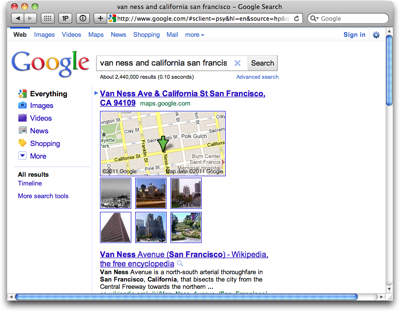
The direct search on Google Maps finds the same location and points it out on the map via a marker.2 A snapshot from Google Street View provides a first impression of what that intersection looks like in real life.
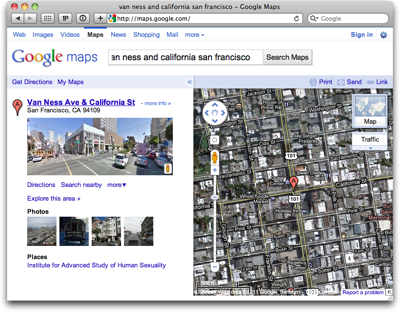
Google’s regular search failed to recognize a search for an intersection in only a few cases. Whenever this happened in my testing, the search contained a street name that has a more general meaning, like “University [Avenue]” or “Harmony [Road].” Adding the missing “street type identifier” — “ave,” “road,” “st,” etc. — reliably fixed the problem every time.
As for the algorithm’s robustness, even something as tricky as “california and berkeley berkeley california” (that’s “California Street at Berkeley Way, in Berkeley, CA”) could not trip the Google search engine. It immediately found the correct location.
Yahoo!
Yahoo!’s regular search finds almost as many matches as Google’s, but fails to recognize “van ness and california san francisco” as a reference to an intersection.
Judging from the inclusion of results that match the search string when replacing “california” with its abbreviation “ca,” the Yahoo! search engine interprets that word as the state, and not as the street that I am looking for.
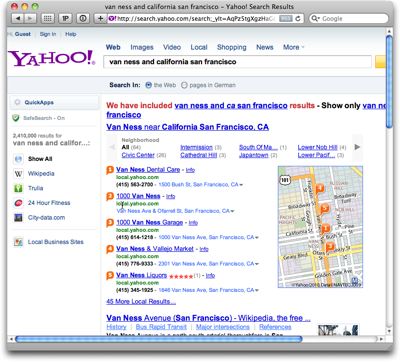
Yahoo! does find a number of locations along Van Ness Avenue and previews these on a small map, but these matches are obviously based on the location’s names instead of their geographical position.
When you click on the small map, you’re taken to a bigger map view on Yahoo! Local, which further confirms this assumption: The original search term has now been separated into a search for businesses whose names contain “van ness” and which are located in “San Francisco, CA” . This is clearly not what I wanted.
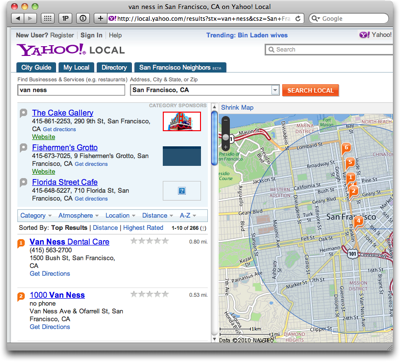
Even when I define my search more precisely by adding “avenue” and “street” to the term, Yahoo! presents similar, and similarly unrequested, results.
Regardless of the specific location, Yahoo!’s generally performs a literal search, so that it will match results based on entities’ names, descriptions, or addresses. The results will not, however, find a street or intersection as such.
Disappointingly, even Yahoo! Maps failed to make sense of my original search term: An error messages stated that “We could not find the exact location you asked for so here’s the center of San Francisco, CA instead.”
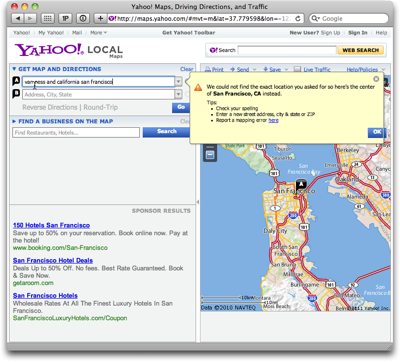
This time, adding “avenue” and “street” to the search did result in a perfectly good match.
In contrast to Google’s map page layout, Yahoo! does not display further information about the location it found. Instead, about a quarter of the actual map view area is taken up by ads (which, thankfully, can be hidden together with the map search form).
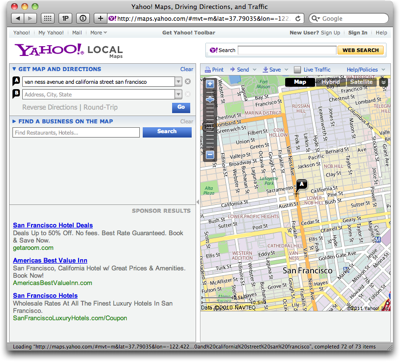
Locations with less ambiguous street names, like “austin and franklin san francisco” work just fine in Yahoo!, but the search algorithm is not as robust as Google’s. Case in point: “california and franklin san francisco” immediately finds this intersection, whereas “franklin and california san francisco” fails.
Bing
In essence, Bing behaves like Yahoo!.
Its regular search fails to properly interpret the search term as a street intersection. The matches it does list are based on “van ness” being contained in these matches’ names or addresses. Only such local results are displayed when you click on the map preview to transition to the Bing Maps site.
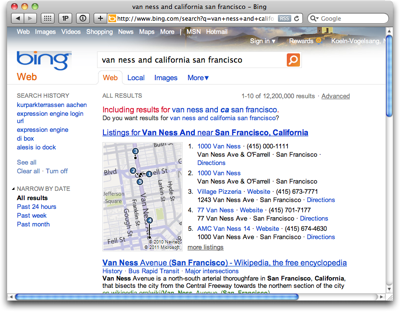
Bing Maps properly deals with intersection searches. Like Google, it expands the street names to include “Ave,” “St,” etc.
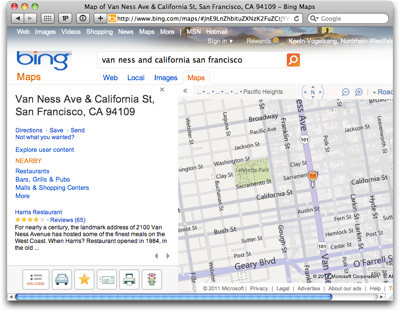
During my random testing, its robustness was better than Yahoo!’s, but not quite on par with Google Maps’ yet.
As an example, the search for “college and harmony fort collins” is too much of a challenge even for Google Maps, but extend it to “college ave and harmony rd fort collins,” and the site immediately finds this intersection.
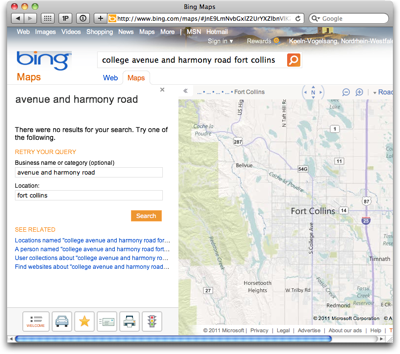
For Bing Maps, that latter search string is still too challenging, even when you click on the “Locations named…” link under “SEE RELATED.”
What’s in a map view
As I had mentioned, this observation started out with me hearing about an intersection in a podcast, and asking myself “What if I search for that intersection by describing it just the way that humans normally do?”
When technology, such as a search engine, is capable of understanding our goals and wishes even when we communicate them in a way that feels natural to us — i.e., in the same way that we communicate among us humans –, then the experience does have a touch of magic to it.
It’s when machines force us to think in machine terms, that this magic immediately goes “poof.”